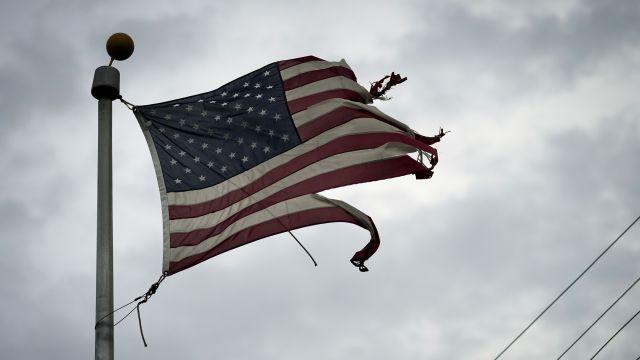It battered a tall building in Lake Charles, blowing out windows as glass and debris flew to the ground, while a floating casino came unmoored and hit a bridge.
But hours after the hurricane made landfall near the Texas border, the wind and rain were still too severe to allow authorities to check for survivors.
Hundreds of thousands of people were ordered to evacuate ahead of the hurricane, but not everyone did so.
A 14-year-old girl was confirmed as the first fatality from the storm. She was killed when a tree fell on her home in Louisiana.

Local officials reported taking numerous calls from people stranded, but voiced concern help could not be sent while the conditions remained dangerous.
The eye passed directly over Lake Charles, and drone footage shows roofs ripped off, exposing living rooms to the elements, trees downed and water overflowing the banks of coastal properties.
Federal Emergency Management Agency administrator Peter Gaynor said the damage reported so far appeared to be less severe than had been feared, but he expects there to have been significant wind damage to buildings once proper surveys of the disaster area are completed.
The National Hurricane Centre said Laura slammed the coast with winds of 150mph at 1am local time near Cameron, a 400-person community about 30 miles east of the Texas border. Forecasters had warned the storm surge would be “unsurvivable” and the damage “catastrophic”.
They predicted a storm surge of 15-20ft in Port Arthur, Texas, and a stretch of Louisiana including Lake Charles, a city of 80,000 people on Lake Calcasieu.

“This surge could penetrate up to 40 miles inland from the immediate coastline, and floodwaters will not fully recede for several days,” the hurricane centre said.
Hours after it arrived, Laura weakened to a Category 2 hurricane, with sustained winds of 100mph.
It is moving north, with damaging winds extending outward as far as 175 miles.
In Cameron Parish, where Laura came ashore, Mr Nungesser said 50 to 150 people refused pleas to leave and planned to endure the storm, some in elevated homes and even in recreational vehicles.
Mr Gaynor urged people in Laura’s path to stay at home, if that is still safe. “Don’t go out sightseeing. You put yourself, your family at risk, and you put first responders at risk,” he told This Morning on CBS.

Forecasters expect a weakened Laura to cause widespread flash flooding in states far from the coast. An unusual tropical storm warning was issued as far north as Little Rock, where forecasters expect gusts of 50mph and a deluge of rain into Friday.
The storm is so powerful that it could regain strength after turning east and reaching the Atlantic Ocean, potentially threatening the densely populated north-east.
Laura hit the US after killing nearly two dozen people on the island of Hispaniola – 20 in Haiti and three in the Dominican Republic.
It is the seventh named storm to strike the US this year, setting a new record for landfalls by the end of August. The old record was six in 1886 and 1916, according to Colorado State University hurricane researcher Phil Klotzbach.







